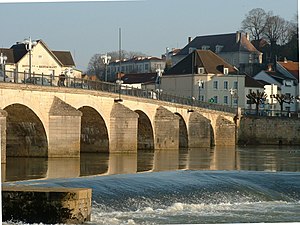Gray, Haute-Saône
Gray | |
|---|---|
| Country | France |
| Region | Bourgogne-Franche-Comté |
| Department | Haute-Saône |
| Arrondissement | Vesoul |
| Canton | Gray |
| Area 1 | 20.26 km2 (7.82 sq mi) |
| Population (2007) | 6,175 |
| • Density | 300/km2 (790/sq mi) |
| Time zone | UTC+01:00 (CET) |
| • Summer (DST) | UTC+02:00 (CEST) |
| INSEE/Postal code | 70279 /70100 |
| Elevation | 187–249 m (614–817 ft) |
| 1 French Land Register data, which excludes lakes, ponds, glaciers > 1 km2 (0.386 sq mi or 247 acres) and river estuaries. | |
Gray (French pronunciation: [ɡʁe]) is a commune in the Haute-Saône department in the region of Bourgogne-Franche-Comté in eastern France. It has a population of 6,175 inhabitants (2007).[1]
Geography
Gray is situated on the banks of the Saône River. It is the last major town in Franche-Comté before the Saône flows into Burgundy.
History
It was, since the Middle Ages, an important river port, an important trading center in Franche-Comté.
Gray is believed to have acquired its name from an old landed estate in its vicinity owned by a family with Gallo-Roman origins bearing the name "Gradus", cognate with the Celtic "Grady" meaning "illustrious" or "noble".
Gray was founded in the 7th century. Its fortifications were destroyed by Louis XIV. During the Franco-German War General von Werder concentrated his army corps in the town and held it for a month, making it the point d'appui of movements towards Dijon and Langres, as well as towards Besançon.[2]
Sights
The town includes many old buildings. An 18th century stone bridge spans the Saône river, connecting the main town with the settlement of Arc les Gray. Gray is a popular place for fishing and various water activities.
Gray's Basilica (Basilique Notre Dame) was built from 1478 to 1559, with a bell tower typical of Franche-Comté.
An art museum, the Musée Château Baron Martin, is housed in the Château of the Count of Provence, brother of Louis XVI, which in the 18th century replaced the fortress belonging to the Dukes of Burgundy. The 12th century "Paravis Tower" is the last remnant of the fortress and offers a panoramic view of the Saône Valley. The museum displays some 1200 pieces of art from the 15th to the 20th century throughout 24 rooms.
The Carmelite chapel (Chapelle des Carmelites) was built in 1667. Since 1978, it has held eight centuries of sacred art in Haute-Saône, including paintings, sculptures, and religious objects.
Gray is the site of France's National Esperanto Museum.
-
La grande bibliothèque
Transport
There is a railway station, an airport and a bus station.
See also
References
- ^ INSEE
- ^ Chisholm, Hugh, ed. (1911). . Encyclopædia Britannica. Vol. 12 (11th ed.). Cambridge University Press. p. 395.










